Keeping your dog in good shape isn’t always easy. Allow your dog to run in the house isn’t enough to exercise him. With more than 50 % of overweight or obese dogs according to APOP, that’s a serious problem. However, there are simple solutions to keep your buddy fit, healthy and happy!
Jogging with your dog is one of the best ways to exercise active companions. Furthermore, it’s also a fun activity to spend quality time with your dog. These furry runners are awesome motivators to keep you both in perfect shape. Nonetheless, it’s not always simple to understand how you can run with your dog!
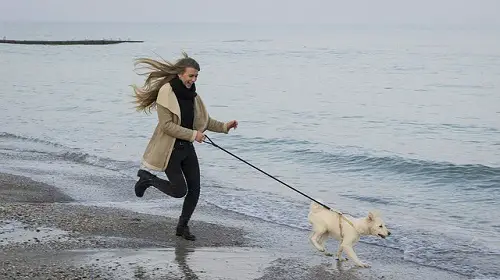
Running with your dog isn’t what’s complicated in itself. It’s more all the conditions and precautions to take that makes this sport difficult to start safely. Teaching your dog how to run is simple when you have the right techniques. With some jogging tips and practice, you should be ready to start running with your dog today!
Even if this canine activity isn’t hard to learn, you won’t be able to run 5 miles tonight or tomorrow. It will take some time, effort and patience to enjoy this sport, but it will be worth it. At the end of your reading, you will have all the information and resources to jog with your dog. Here are some things every dog owner should know before running with their dog!
21 Dos and Don’ts To Run With Your Dog!
These training tips will help you to enjoy this dog sport more safely and easily. If you consider starting any kind of running, you must read this article. It will guide you to know how to get started, if your dog is suitable to run, and much more essential information. I’m sure it will help you provide more proper exercise to your companion and make you both healthier and happier!
Many people ask if running is safe for dogs. The safety of your companion will always depend on your precautions. Informing yourself as you do is already a good first step. Now, you just need to read to the 21 dos and don’ts to run with your dog safely. Moreover, make sure to always respect your dog’s conditions and limits!
Do: Master Dog Walking!
Before you do more advanced training with your dog, you need to understand the basics. It’s crucial to master the right way to walk to run safely with your companion. Without that knowledge, you will be most likely to hurt you both with jogging!

If you have never walked with your dog before, you should seriously consider it. Assure you to don’t make things upside down. You can only run with your buddy if you master loose-leash walking!
Do Not: Start Too Young!
Unfortunately, puppies aren’t suitable to be your running partner. These young buddies are way too fragile to enjoy intense dog sports. Even slow jogs could damage your pup’s bones or joints because of the constant impacts. It’s not safe to run your dog if he’s still growing because their structure isn’t solid enough!
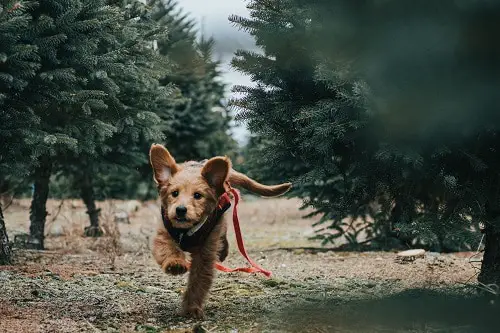
When it’s OK to introduce your dog to run with you? It depends. Chihuahuas don’t have the same growth time as giant dogs such as Great Danes or other Mastiffs breeds. Even in the same breed, some furry friends could be fully grown at different ages. The time your buddy takes to reach his full height is a good element to know when it’s OK to run!
Normally, medium to large dogs (Labs and Goldens, Collies, Boxers, etc.) takes on average 18 months to reach their full growth.
Smaller breeds (Beagles, Chihuahuas, Yorkshire Terriers, etc.) could have a growth time between 12 and 15 months.
Larger dogs (Great Danes, Mastiffs, Newfoundlands, etc.) could take up to 3 years before their full height.
Therefore, you should do a quick search on google («Your Dog’s Breed» Growth Time) to see when it’s safer to run with your dog. However, most healthy dogs are ready to run around 10 to 12 months of age. Asking your vet will be the most efficient way to know if your puppy is ready to run with you!
Do: Make Sure Your Dog Is Suitable To Run!
Did you know that not every dog can run safely? Like humans, dogs can have some conditions that restrict them to run. There’s not a lot of buddies that won’t be suitable to run, but it’s crucial to assure that your dog isn’t one of them. Running with him could be very painful or cause serious injuries if he isn’t suitable for intense canine sport!
How To Know If Your Dog Is Suitable To Run or Not?
There are many elements such as his breed, health, structure, energy, weight, size and other things to look at. That might seem very complicated, but don’t worry it’s not. Many people think the breed is the most influential trait to run with your dog. Your companion’s origin is effectively important but less than his health!

For example, Chihuahuas are not the best jogging buddies but could be interesting for short distances if they are in good health. On the contrary, Labradors are awesome running partners but could be not suitable because of medical or structural restrictions!
Do Not: Stereotype Your Dog!
This is directly linked with the previous «Do» when you’re analyzing your dog’s capacity to run. Too many dog owners stereotype their companions especially because of his breed. The problem is that they take only one of several traits to assume their pooch is a good runner!
For example, Corgis could seem like good running partners because they are high-energy dogs. For their size, they are impressive runners but they won’t be able to jog more than 1 or 2 miles (1.6 or 3.2 km). Their energy isn’t enough to make them awesome jogging companions for long distances. You need to consider their little legs and unproportionate cute body.

There are many other examples, but you simply need to understand that you should consider every element that makes your dog suitable to run. Don’t assume your dog is a runner, analyze it!
Do: Visit Your Vet Before To Run!
Before you hit the road, it’s highly recommended to visit your veterinarian. Whenever you change your dog’s exercise regimen, you should visit a professional. That’s especially true for those who aren’t sure if their companions are suitable to run. Moreover, your vet could answer all your specific questions and give you personalized advice!
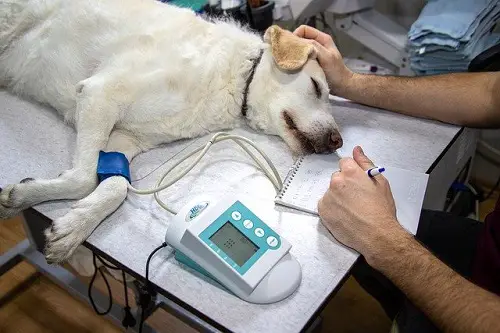
That’s always more efficient and safe to visit your vet before you run with your dog. It can also be very useful and avoid unnecessary problems. Every dog is unique, so they all have different conditions and exercise needs!
Do Not: Run With These Dogs!
As you know, some dogs aren’t suitable for running sports. Nonetheless, I didn’t give you a lot of details on which types of companions shouldn’t run with their owner. Here are some more specific dog types that aren’t well-suited to jog!
Unhealthy Dogs.
Having good general health is important to enjoy canine sports safely. If your dog isn’t healthy, please consider changing his habits before running with him. Healthy habits such as proper nutrition, good exercise routine, and regular playtime are interesting to keep your dog in good shape!
Overweight Buddies.
Most dogs with extra pounds (or kg) won’t be comfortable to run. Too much pressure on their joints could hurt or injure them. If your companion is obese, you have to consider trying lower intensity activities and put him on a diet instead of running!
Senior Dogs.
Age is really important when it’s time to exercise your buddy. After 7 or 8 years old, dogs will be less active and more fragile. You should decrease the intensity of your runs with a senior dog. Moreover, you will have to stop when this sport can become painful or dangerous for him!
Brachycephalic (Short-Nosed) Pooches.

Short-nosed dogs have a respiratory issue that will restrict them to breathe well and regulate their temperature while running. That’s why you should be very careful with them by slowing down the pace and doing shorter distances.
Brachycephalic Dogs: Bulldogs, Pugs, Boxers, Boston Terriers, Shih Tzus, Chihuahuas, Chow Chows, Pekingese Dogs, Bull Mastiffs, English Toy Spaniels, etc.
Ultra-Small or Giant Dogs.
The size of your dog has a real influence on his capacity to run. Some very small companions won’t be able to keep up with your pace or are simply too fragile to run. Giant buddies are so heavy that it could hurt or/and restrict them to run long distances!
Do: Give It a Try!
The best way to know if your dog can run is to give it a try. I’m not telling you to go for a 5 miles (8 km) jog right now to see if your buddy can survive it. Just with an off-leash run of 0.5 or 1 mile (0.8 or 1.6 km), you will be able to analyze how he can run short distances. If his running abilities for short bursts or sprints are good, he probably won’t have problems running a little bit longer distances with you!
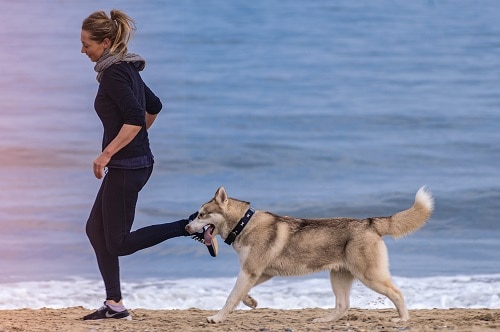
Overall Running Skills
With this «Running Test» you can not only see your dog’s athletic potential but also how much he loves this sport. Even if he’s poorly suited to run, with some training and time, it could change. So, if you’re still not sure that your buddy can keep up with you while running, go outside and run! (You could be surprised!)
Do Not: Let Your Dog Pull!
If your dog is used to walking on a leash, this won’t be a problem. That’s another reason why master loose leash walking is so important. Teaching your buddy to not pull while running isn’t very easy. Make sure to have good running habits from the start to avoid future problems or accidents!
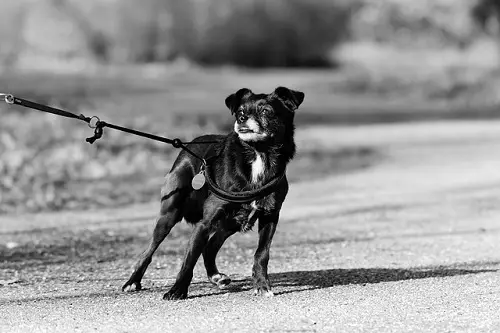
Even for experienced dogs or runners, it’s recommended to use short leashes (4 to 6 foot or 120 to 180 cm) to run with your buddy. He should be extremely close to you especially at the start. This will give you more control and be safer for your dog. Don’t forget to reward him with treats or more freedom for being good!
Do: Learn The Right Way To Run With Your Canine!
There are many ways to teach your dog how to run. When you start to increase the pace of your walking to jogging, most dogs will keep up automatically. Some natural runners will even try to lead, but you need to stop them. That’s where you need to restrict them to pull and take the lead with obedience training or other methods.
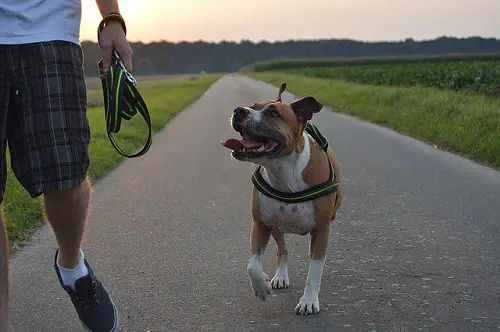
Some ways are more simple and efficient than others. My 3 steps process is very useful for anybody that would like to run with their dog. The first step is simply to master loose leash dog walking. The second step is to try walk-jog cadence with your buddy and increase the distance slowly. The last step is to finally start running with your dog!
Do Not: Neglect Warm-Ups!
Just like humans, dogs should have time to warm up before they run. This will prevent you both from unnecessary injury or pain. You should consider adding any kind of routine to warm up both of your muscles!

For example, starting with a short walk or jog to prepare you to run. Moreover, dogs love to have a routine, so warm-ups could be part of it. Too many people (including me before) don’t take the time to prepare their bodies and muscles before running. I highly recommend you to do it to protect you both against injuries!
Do: Start With Short and Slow Runs!
You can’t start with 5 miles runs without any preparation. Like any other sports, it will take time for both of you before to be good runners. Furthermore, some dogs won’t be able to jog long distances. That’s why it’s so important to start short and slow!
Most dogs will be OK to run anywhere from 2 to 5 miles (3 to 8 km). To start running I would recommend shorter distances such as 1 mile or kilometer to slowly increase it. After a few weeks or months of training, it will be safer for both of you to enjoy gradually more intense, long or frequent runs!
Do Not: Run In Extreme Heat!
It’s a beautiful sunny day and you would like to go on a run with your dog? You should be very careful to not over-exercise your buddy in the summer especially on hot days. Running in the heat could even kill your companion in extreme conditions. Be aware that these furry animals can’t tolerate extreme heat like humans!
Most dogs can tolerate hot temperatures up to 80°F or 27°C. However, it will vary a lot depending on the dog’s breed, their fur coat type, etc. Every dog will deal with extreme temperatures differently. In general, healthy companions with a short coat, long nose, good shape, and long ears are more suitable to run when it’s hot!
Here Are Some Dog Breeds That Tolerate The Heat Well!
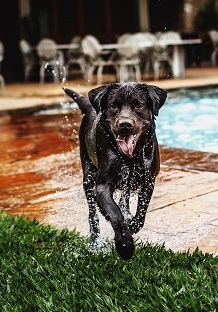
- Australian Cattle Dogs.
- American Foxhounds.
- Dalmatians.
- German Shorthaired Pointers.
- Golden Retrievers.
- Great Danes.
- Poodles.
- Labrador Retrievers.
- Most Terriers.
- Border Collies.
- Dobermans.
- Vizslas.
- Weimaraners.
- Etc.
Even with these dogs, that’s never safe to run when the weather is too hot. Be very careful with intense exercise on sunny days to avoid your pooch to overheat or heat stroke. Make sure to try indoor, lower energy activities or swimming when it’s too hot to run outside!
Do: Have These Running Gear or Accessories!
Running with your dog isn’t complicated at all. However, there is some equipment that you will need to enjoy this sport safely. Don’t worry, running with your dog won’t be expensive at all. It shouldn’t cost more than $50-$100. Investing in good gear is important to run safely and with more comfort!
Here Are Some Things That You Should Have To Jog With Your Dog!
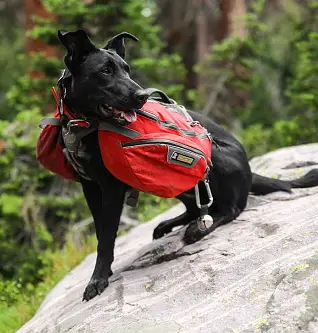
- Some Water.
- Snacks.
- Good Running Shoes.
- Fitness Clothes.
- A Leash. (Normal or Hand-Free.)
- A Collar or Dog Harness.
- Travel Bowl. (Optional)
- Etc.
For more advanced runners, there are other important equipments that you should consider. For short runs, a leash, collar, and some water should be alright to start!
Do Not: Run When It’s Too Cold!
Are you living where it can be freezy sometimes? Make sure to not bring your dog out when it’s too cold. Even if these animals can have thick fur coats, some of them don’t. Therefore, you need to make sure your buddy is suitable to tolerate the cold while running!
Here Are a Few Dog breeds That Can Run In Cold Temperatures!

- Siberian Huskies.
- Shiba Inus.
- Samoyeds.
- German Shepherds.
- Bernese Mountain Dogs.
- Alaskan Malamutes.
- Akitas.
- Etc.
Some dogs were bred to live in temperatures up to -60°F (-50°C) such as Huskies or Malamutes. That’s impressive but not all companions can withstand such cold temperatures. Normally, most dogs shouldn’t go out when it’s under 40-45°F (4-7°C)!
Do: Teach Running Commands!
Voice cues are very interesting to have more control over your companion while running. That could be very useful to enjoy more advanced canine sports such as canicross or long-distance jogs. Before doing so, you will need to already have taught your dog the basic commands!
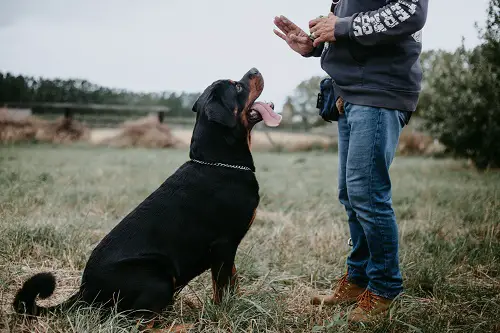
There are simple running voice cues that everyone should teach to their buddy. For example, «Let’s Go», «Get Running» or «Move It» to tell your dog it’s time to move on. (AKC suggestions) Other things such as «Whoa» or «Easy» to slow down, «On By» to avoid a distraction, etc. To do canicross, you will need way more specific cues!
When Can You Teach These Running Voice Cues?
You shouldn’t start teaching commands to your dog during any kind of intense sport. The best time to teach him running voice cues is during your daily walks. That way will be easier and safer to start more advanced canine activities or dog training!
Do Not: Forget To Cool Down!
You remember that warm-ups are interesting to avoid injuries. Therefore, that’s just logic to not neglect a cool-down session after intense canine sports such as running. It’s always good for humans or dogs to not stop suddenly after a vigorous physical effort. Slowly returning to a normal energy level is also good to reduce stress on your buddy’s joints!
What Can Be Your Cool Down Routine?
Like warm-ups, it’s not obligated to be very long. Just about 5 minutes of slow walking after running could be awesome to cool down. That’s perfectly enough to give your dog the time to regulate his body temperature and breathing to a normal state. After that, you could consider stretching your dog or giving him a canine massage for his well-being!
Do: Keep Your Dog Hydrated!
Giving a lot of water is important to keep your dog healthy and safe while running. He should drink anywhere from 0.5 to 1 ounce per pound (15 to 30 ml/lbs or 7 to 14 ml/kg). Unfortunately, Your buddy can’t tell you when they are thirsty, so you need to check for dehydration signs. Here are some things to look at to know if your dog needs water!

- Dry Nose.
- Elastic Skin.
- Dry Gum Tissue.
- Heavy Panting.
- Dry Looking Eyes.
- Weakness.
- Lethargy.
- Etc.
You shouldn’t see any of these signs if you give enough water to your buddy. Stopping every 10 minutes for water breaks is also recommended. Besides, a travel bowl could be interesting to keep your dog hydrated at any time! Nonetheless, don’t give too much water or food to your dog before intense activity. This could cause him cramps, bloating or even nausea!
Do Not: Forget Frequent Breaks!
Water breaks shouldn’t be the only time you stop while you working out. While running, dogs will need many opportunities to stop fulfilling their needs. It could be as simple as go pee, poop or that they can’t keep. When he needs a break, he will make you some kind of sign or act weird. Therefore, you just need to make sure to learn your dog language!
Your dog will need several breaks to not get over-exercise, especially at the start. This will also allow him to recharge, go to the bathroom, sniffing around, and enjoy his run. After building up some stamina, you could start to enjoy longer jogs without (or with less) pause. However, it’s always important for both of you to have enough rest time between your workouts!
Do: Pay Attention To Your Dog!
This is probably one of the most important things that many runners neglect. It’s very sad to see someone jogging with his dog without looking at him. Moreover, that’s not only irresponsible, but it can also be very dangerous for your companion. If anything is not OK while running, your furry partner will make your signals. Nonetheless, if you don’t pay attention to your dog, these signs are useless!
Over-exercising your dog isn’t difficult at all. You can trust me that he won’t stop running even if it hurts him. These pets don’t know how to pace themselves safely, so they will follow you. That’s why it can be dangerous to run with fragile companions such as senior dogs, puppies, overweight companions, etc. They won’t be able to respect their limits, so you need to do it!

Here Are Some Signs That You Over-Exercise Your Dog!
Short Term:
- Heavy Panting.
- Sluggishness.
- Difficulty to Keep Up.
- Drooling.
- Decreased Stamina or Energy.
- Confusion.
- Disorientation.
- Collapse.
- Etc.
Long Term:
- Paw Injuries.
- Sore Muscles.
- Joint Injuries.
- Behavioral Changes.
- Etc.
If your companion has any of these symptoms, please stop exercising immediately and rethink he’s workout routine. Be very careful to notice these signs before things get worse. Just pay attention to your dog, and everything should be fine. Always assure you that he’s alright before, during, and after every run!
Do Not: Allow Off-Leash Anywhere!
Dogs will love to have the opportunity to run free without any leash. However, this isn’t always safe, legal or appropriate to enjoy off-leash running. This kind of reward is awesome for well-trained dogs, but not for young, anxious or disobedient companions. Besides, some breeds have a hunting or fighting instinct that could be problematic to do off-leash safely!
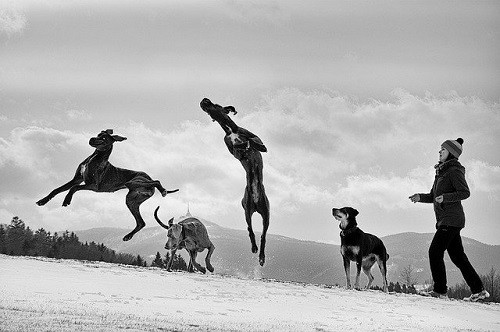
You just need to have enough control over your buddy to make him come back to you avoiding distractions. That’s not safe at all to do off-leash without any practice. For example, you could practice your recall command at an off-leash dog park. Once your pooch comes back to you at every recall, you can consider trying off-leash during a run at a safe place and time. Giving him more freedom can be very good to prevent boredom, stress, anxiety or even depression!
Do: Have Fun With Your Buddy!
Everyone should know that running with your dog is an awesome way to make you both in better shape. However, this sport doesn’t only have several physical and mental health benefits. That’s also an awesome way to have a lot of fun with your companion. Unfortunately, many dog owners have forgotten that opportunity to enjoy canine activities. I hope that’s not your case!
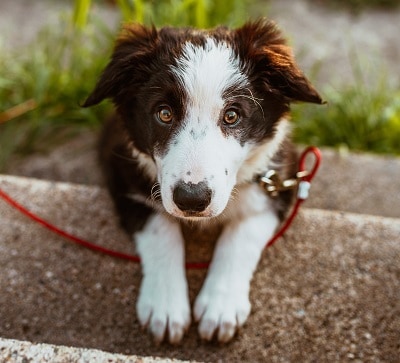
I just want to make you realize how much you can have fun while running with your dog. Not everybody has the chance to run with their furry companion. If you have that opportunity, don’t let it go. Furthermore, you should try to enjoy this physical activity with a large smile on your face!
Yet, running sports are not for every dog owner. If you don’t like to run, I don’t recommend you to do it only to exercise your companion. Anyway, I’m sure he will love to spend time with you whatever canine activity you want to do. Thankfully, there are many other fun things for people that don’t like to run!
Some Alternatives To Running With Your Dog!
- Swimming.
- Biking.
- Play in Water, Leaves or Snow.
- Dog Agility.
- Teach Him New Tricks.
- Play Fetch or Frisbee.
- Teach Him To Use The Treadmill.
- Flirt Pole.
- Etc.
There are so many activities to do with your dog, it’s sure you will find something that you both like. Keep in mind that it’s always important to provide enough physical and mental activity to your companion. Most dogs will need around 30 to 60 minutes of exercise every day with some intellectual stimulation. Assure you to give plenty of playtime to your furry friend to keep him in good shape, healthy and happy!
Dog Sports For Owners That Like To Run With a Furry Friend!
Canine activities can be very fun especially when you like physical stimulation. However, jogging with your dog can indeed become repetitive and a little bit boring. So, I found some other things to try with dogs for running lovers.
Original Ways To Run With Your Companion!

- Canicross.
- Hiking.
- Play Tag or Chase.
- Off-Leash at The Dog Park.
- Free Running.
- Active Fetch.
- Dog-Friendly Races.
- Agility Course.
- Dock Jumping.
- Flyball.
- Skijoring With Dogs.
- Etc.
Last Thoughts About Running With Your Dog!
Finally, there are probably more things to know about running with dogs than you thought. From the right way to teach your pooch how to run to the importance of having fun during this activity, it’s a lot of information. That’s plenty of things to remember but don’t worry, running with your dog is relatively a simple sport to enjoy. After some practice, you will have a way to keep you both healthy and happy for many years!
I hope you have learned many things about how to run safely with your dog. This intense activity is something that can help you to be more active with your companion. Running with your dog has several benefits both for the furry pet and his human. That’s why every active canine owner should try this awesome dog sport. I would like to meet you on running trails with my Labrador!
